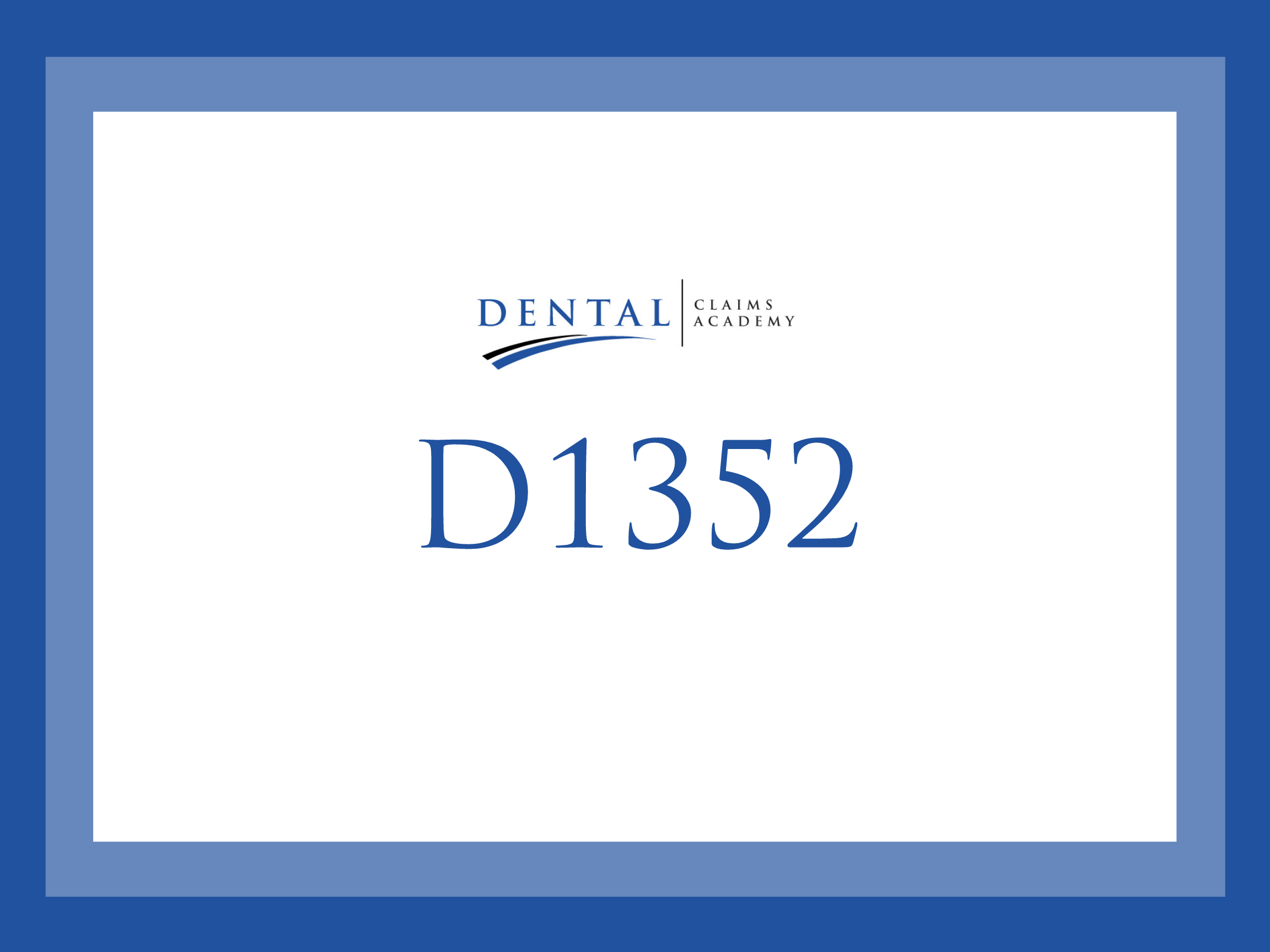Examining CDT Code D1352: What is the difference between a Sealant vs Preventive Resin Restoration vs Filling?


Is it a sealant, preventive resin restoration or a filling? What’s the difference?
A common coding error is incorrectly reporting a preventive resin restoration, referred to as PRR.
Dental ClaimSupport is a trusted dental billing party that has spent the past few years developing our educational platform, Dental Claims Academy. DCA's purpose is to help dental teams avoid coding and billing errors through formal training and education.
During our years of assisting thousands of dentists navigate the proper billing for a PRR, we have found that the code D1352 is commonly misunderstood.
This article will review the difference between a sealant, PRR, and a filling to ensure proper coding. With this knowledge, you will be able to confidently code with fewer errors. This will lead to more claims income for your dental practice, because you will face fewer denials.
What is a sealant?
Premolar and molar teeth have what is known as pits and fissures, or deep grooves, on the occlusal (chewing) surface of the teeth.
These grooves are necessary for chewing and grinding food but can become troublesome when bacteria collects in these “deep grooves” and can not be removed properly with a toothbrush. As permanent teeth erupt (come in), a sealant is placed on the occlusal surface and in these grooves to keep bacteria from collecting, thus preventing decay (cavities) from forming.
This procedure is not limited to children with newly erupted teeth but is most common because the sooner the occlusal surface can be sealed, the less likely decay will occur.
Most teeth require only a preparation of the enamel surface using a chemical method, such as etching, while some may require mechanical preparation such as with a handpiece.
A sealant is usually placed by a hygienist or assistant. Preparation of the enamel surface by a dentist using a handpiece or bur is generally not needed. Sealants may need to be replaced from time to time due to normal wear and tear of daily chewing function.
A sealant is documented and reported using code D1351. D1351 is indicated for primary or permanent teeth.
D1351 sealant – per tooth
Mechanically and/or chemically prepared enamel surface sealed to prevent decay.
What is a Preventive Resin Restoration (PRR)?
A PRR is a procedure to prevent decay, similar to a sealant. However, there is staining or decay in the pit and fissure of the tooth that does not extend into the dentin layer of the tooth. Simply put, the decay is limited to the enamel layer of the tooth.
For this procedure, it is necessary for a dentist to prepare the tooth, using a handpiece and a bur. Any staining and decay is removed from the enamel surface thus preventing any further decay. A resin restoration is placed in the prepared tooth surface. A PRR is more of a definitive restoration unlike a sealant which may need to be replaced from time to time.
A PRR is documented and reported using code D1352. It is important to note that any sealant placed on any non-carious pits or fissures is inclusive to D1352. D1352 is indicated for permanent teeth only for moderate to high caries risk patients.
Related: Enroll your team in Dental Claims Academy to learn more about dental procedure codes.
Your clinical documentation should include a caries risk assessment. While most payers do not require submission of the caries risk assessment, a payer may ask for this supporting documentation for claim adjudication purposes or during an audit.
Additionally, documentation should include that decay or staining extended into the dentin and was removed. It is also beneficial in proving medical/dental necessity to have an intraoral image as supporting documentation.
D1352 preventive resin restoration in a moderate to high caries risk patient – permanent tooth
Conservative restoration of an active cavitated lesion in a pit or fissure that does not extend into dentin; includes placement of a sealant in any radiating non-carious fissures or pits.
What is a dental restoration procedure?
A tooth with an activated carious lesion extending beyond the enamel into the dentin layer of the tooth is appropriately reported as a restoration or filling. For example, when decay extends beyond the enamel into the dentin and a composite resin restoration is placed, this procedure is appropriately reported as a composite restoration.
Your documentation must include that the decay extended into the dentin. All supporting documentation also must prove the decay extended into the dentin.
For example, occlusal decay does not typically show on a bitewing radiographic image, but it may exist and extend into the dentin. The best supporting documentation in this instance is your intraoral camera image.
Failure to document decay extended into the dentin in your clinical notes and no supporting documentation such as an intraoral image can be problematic for a practice, particularly in an audit situation. Proving medical necessity is a must for all procedures.
Document and report restorations using the appropriate restoration code found in the D2xxx section of Current Dental Terminology (CDT) code set.
Failure to document extent of decay can result in monies recouped by the payer
Payers perform audits for various reasons. An audit could be prompted by a utilization review of certain codes or random. It is not uncommon for a payer to audit a practice when there is high reporting of 1 or 2 surface composite premolar and molar restorations.
During the audit, the payer will be reviewing the documentation to verify the reason for the composites. Review will confirm the procedure was not for cosmetic purposes such as removal of existing amalgams restorations replacing with composite material.
If your documentation does not indicate the decay and prep extended into the dentin and you have no supporting documentation, then you may be asked to return funds received. If your documentation can only support that the prep is into the dentin, you may only be allowed to keep the benefit you would have received for a preventive resin restoration.
This can result in refunds of thousands of dollars to the payer and to the patient.
Don’t let small CDT code details confuse you
This article has confirmed the following differences between a sealant, preventive resin restoration and filling.
- Sealant: No decay exists, sealant material is placed on the occlusal surfaces, in the pit and fissures
- Preventive Resin Restoration: Active decay exists but is limited to the enamel layer of the tooth
- Filling: Active decay exists and extends into the dentin layer of the tooth
Be sure your documentation proves dental/medical necessity. Your intraoral camera is a must in addition to a radiographic image when decay does not show on the radiographic image.
Train your team, have specific protocols on documentation requirements. Invest in ongoing continuing education for your entire team through our Dental Claims Academy. Our webinars are available for purchase.
Current Dental Terminology, © 2020 American Dental Association. All rights reserved.
Related Posts
Dental billing resources

